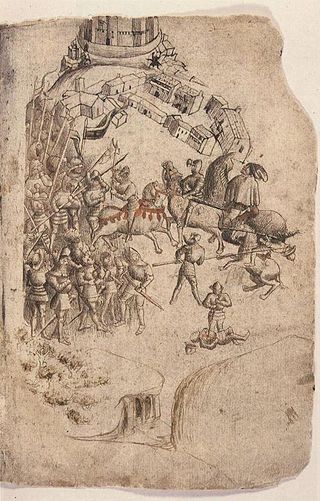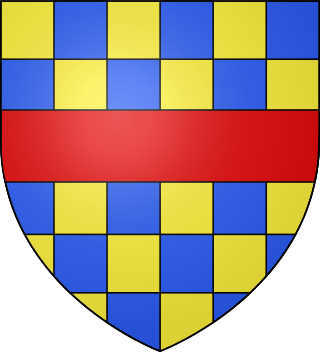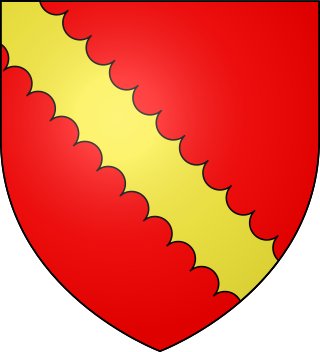Related Research Articles

The Wars of Scottish Independence were a series of military campaigns fought between the Kingdom of Scotland and the Kingdom of England in the late 13th and 14th centuries.

The Battle of Bannockburn was fought on 23–24 June 1314, between the army of Robert the Bruce, King of Scots, and the army of King Edward II of England, during the First War of Scottish Independence. It was a decisive victory for Robert Bruce and formed a major turning point in the war, which ended 14 years later with the de jure restoration of Scottish independence under the Treaty of Edinburgh–Northampton. For this reason, the Battle of Bannockburn is widely considered a landmark moment in Scottish history.

Elizabeth de Clare, 11th Lady of Clare was the heiress to the lordships of Clare, Suffolk, in England and Usk in Wales. She was the youngest of the three daughters of Gilbert de Clare, 6th Earl of Hertford and Joan of Acre, and sister of Gilbert de Clare, who later succeeded as the 7th Earl. She is often referred to as Elizabeth de Burgh, due to her first marriage to John de Burgh. Her two successive husbands were Theobald II de Verdun and Roger d'Amory.
Humphrey (VII) de Bohun, 4th Earl of Hereford was a member of a powerful Anglo-Norman family of the Welsh Marches and was one of the Ordainers who opposed Edward II's excesses.
Margaret Wake, suo jure3rd Baroness Wake of Liddell and Countess of Kent, was the wife of Edmund of Woodstock, 1st Earl of Kent, the youngest surviving son of Edward I of England and Margaret of France.

Eleanor de Clare, suo jure 6th Lady of Glamorgan was a powerful Anglo-Welsh noblewoman who married Hugh Despenser the Younger, the future favourite of Edward II of England, and was a granddaughter of Edward I of England. With her sisters, Elizabeth de Clare and Margaret de Clare, she inherited her father's estates after the death of her brother, Gilbert de Clare, 8th Earl of Gloucester, 7th Earl of Hereford at the Battle of Bannockburn in 1314. She was born in 1292 at Caerphilly Castle in Glamorgan, Wales and was the eldest daughter of Gilbert de Clare, 6th Earl of Hertford, 7th Earl of Gloucester, 5th Lord of Glamorgan and Princess Joan of Acre.
Llywelyn Bren, or Llywelyn ap Gruffudd ap Rhys / Llywelyn ap Rhys or in English: Llywelyn of the Woods. He was a nobleman who led a 1316 revolt in Wales in the reign of King Edward II of England. It marked the last serious challenge to English rule in Wales until the attempts of Owain Lawgoch to invade with French support in the 1370s. Hugh Despenser the Younger's reputedly unlawful execution of Llywelyn Bren helped to lead to the eventual overthrow of both Edward II and Hugh.

Walter Stewart was the 6th Hereditary High Steward of Scotland and was the father of King Robert II of Scotland, the first Stewart monarch.

Robert de Clifford, 1st Baron de Clifford, of Appleby Castle, Westmorland, feudal baron of Appleby and feudal baron of Skipton in Yorkshire, was an English soldier who became 1st Lord Warden of the Marches, responsible for defending the English border with Scotland.
Gilbert de Clare, 8th Earl of Gloucester, 7th Earl of Hertford was an English nobleman and military commander in the Scottish Wars. In contrast to most English earls at the time, his main focus lay in the pursuit of war rather than in domestic political strife. He was the son of Gilbert de Clare, 7th Earl of Gloucester, and Joan of Acre, daughter of King Edward I. The older Gilbert died when his son was only four years old, and the younger Gilbert was invested with his earldoms at the young age of sixteen. Almost immediately, he became involved in the defense of the northern border, but later he was drawn into the struggles between Edward II and some of his barons. He was one of the Lords Ordainers who ordered the expulsion of the king's favourite Piers Gaveston in 1311. When Gaveston was killed on his return in 1312, Gloucester helped negotiate a settlement between the perpetrators and the king.

Baron Morley was a title in the peerage of England. On 29 December 1299 William Morley, lord of the manor of Morley Saint Botolph in Norfolk, was summoned to Parliament, regarded as the creation of a hereditary barony. At the death of the sixth baron in 1443, the title was inherited by his daughter Eleanor Morley, the wife of Sir William Lovel, who was summoned to parliament as Baron Morley in right of his wife and died in 1476, shortly before her. It was then inherited by their son Henry Lovel, following whose death in 1489 it came to his sister Alice Lovel, who was married to Henry Parker. The title was then held by her descendants in the Parker family until 1697 when, on the death of the fifteenth baron without children, the title came to an end.
Events from the 1310s in England.
Isabel de Verdun, Baroness Ferrers of Groby was an heiress, who was related to the English royal family as the eldest daughter of Elizabeth de Clare, herself a granddaughter of King Edward I of England. When she was a child, Isabel was imprisoned in Barking Abbey, along with her mother and half-sister, after her stepfather had joined the Earl of Lancaster's ill-fated rebellion against King Edward II. Her husband was Henry Ferrers, 2nd Baron Ferrers of Groby.
Marshal of Ireland or Earl Marshal of Ireland is a hereditary title originally awarded to William Marshal, 1st Earl of Pembroke in the Lordship of Ireland, which descended to Baron Morley. The title of Marshal, like that of Baron Morley, has been in abeyance since 1697. William Lynch in 1830 described the duties attached to the office before it became ceremonial:
John Comyn IV, Lord of Badenoch was the son of John III "The Red" Comyn, former leader of Scottish rebels against the English, who was killed by Robert the Bruce in the Greyfriars church in Dumfries on 10 February 1306. He was sent to England after his father's death by his mother Jeanne de Valence.
Robert Morley, 2nd Baron Morley, was a distinguished English administrator and military leader who fought on land and sea in wars against Scotland, Castile, and France.

William Marshal, 1st baron Marshal, was a minor English noble that held the position of marshal of Ireland. He was a member of the Marshal family through a collateral line.

John Lovel, 2nd Baron Lovel, Lord of Titchmarsh, was an English noble. He was killed during the Battle of Bannockburn against the Scots on 23 or 24 June 1314.

The Marshal family was a noble family of Anglo-Norman origins. Their name, Marshal, derives from the Frankish term for “a person who tended horses”. By 1066 the term was used for a position in royal and aristocratic households.
Sir John Marshal (1170?–1235) was an English baron and justice.
References
- 1 2 Cokayne, George Edward (1887). Complete peerage of England, Scotland, Ireland, Great Britain and the United Kingdom. Harvard University. London, G. Bell & sons.
- ↑ Armstrong, Peter (2002-03-20). Bannockburn 1314: Robert Bruce's great victory: No.102. Graham Turner. Oxford: Osprey Publishing. ISBN 978-1-85532-609-5.
- ↑ Banks, Thomas Christopher (1807). The dormant and extinct baronage of England; or, An historical and genealogical account of the lives, public employments, and most memorable actions of the English nobility who have flourished from the Norman conquest. London: J. White. pp. 356–357., “To whom succeeded Robert De Morley, his son; who having married Hawyse, sister and heir to John le Mareschall, of Hengham, in com. Norf. had livery of the lands of her inheritance, the 10th of Edward II. Which Hawyse held the office of marshal of Ireland by descent.”